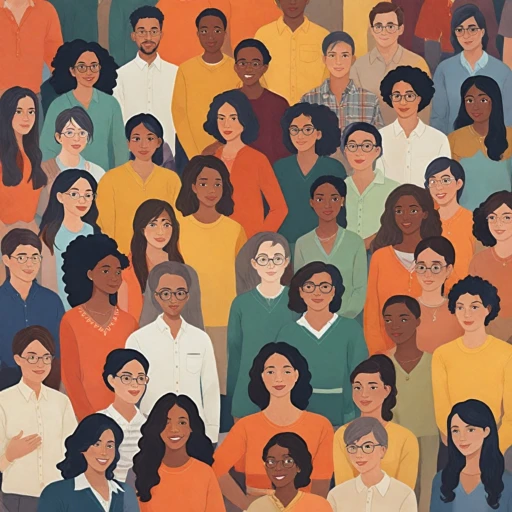Understanding DEI: What Does DEI Stand For?
Defining DEI: It's More Than Just Acronyms
When we talk about DEI, we're diving deep into three crucial pillars: Diversity, Equity, and Inclusion. Think of these as the core ingredients in creating an environment where everyone, irrespective of their backgrounds, feels valued and empowered.
Diversity: Embracing Different Perspectives
Diversity refers to the myriad ways in which people differ. It's not just about race or gender – it's about recognizing and valuing a mix of everyone’s backgrounds, experiences, perspectives, and abilities. A McKinsey & Company study found that gender-diverse companies are 21% more likely to outperform their peers.
Equity: Leveling the Playing Field
Equity is all about fairness. It’s the process of ensuring that everyone has access to the same opportunities by recognizing and rectifying the unique challenges that underrepresented groups might face. For instance, the Equal Employment Opportunity Commission (EEOC) reports that Black employees still face systemic hurdles in the workplace, necessitating equity-focused initiatives.
Inclusion: Making Everyone Feel Part of the Team
Inclusion means creating spaces where everyone feels respected, accepted, and valued. It’s about fostering a culture where diverse individuals can thrive. 78% of employees in inclusive workplaces are more engaged, according to a SHRM survey. This includes measures to prevent employment discrimination based on gender, sexual orientation, or other factors.
Combating Employment Discrimination
Discrimination in the workplace spans a range of issues, from biases in hiring to unequal pay and lack of representation. Title VII of the Civil Rights Act of 1964 protects against employment discrimination based on race, color, religion, sex, or national origin. Despite these protections, 42% of women report facing discrimination at work.
A Spotlight on Affirmative Action
Affirmative action involves proactive steps that promote the inclusion of underrepresented groups in the workplace. Though sometimes controversial, it remains a critical DEI effort that supports truly inclusive employment practices. Florida Governor Ron DeSantis has sparked debates over state policies impacting these initiatives.
Why Diverse Teams Outperform
Diverse teams bring a broader range of perspectives, which can lead to increased creativity and problem-solving abilities. Companies with a rich mix of employees tend to perform better financially. This aligns with findings from the McKinsey & Company, showing that ethnically diverse companies are 35% more likely to surpass industry averages.
Beyond Buzzwords: Real Impacts of DEI in the Workplace
DEI isn't just trendy jargon – it’s a pivotal approach for business success. Companies that invest in diversity, equity, and inclusion programs not only gain a competitive edge but also create a more engaged and productive workforce. Take a peek into this essential strategy for ensuring mental agility in modern organizations.
The Business Case for DEI: Why Companies Prioritize It
The Business Advantage of DEI Commitment
When companies truly embrace Diversity, Equity, and Inclusion (DEI), they're not just doing the right thing—there's a solid business case to be made for these initiatives. Research consistently underscores why prioritizing DEI makes sense not only ethically but also financially.
DEI and Financial Performance: Numbers that Speak
In a well-quoted study by McKinsey & Company, companies in the top quartile for gender diversity were 25% more likely to have above-average profitability. Moreover, those leading in ethnic diversity boasted a 36% greater chance of outshining their less diverse counterparts. These figures emphasize the measurable financial upside of fostering a DEI workplace.
Boosting Innovation through a Diverse Workforce
Innovation thrives in environments where varied perspectives collide. According to a Boston Consulting Group (BCG) study, companies with more diverse management teams generated 19% more revenue from innovation compared to those with below-average leadership diversity. This dynamic injects fresh ideas and viewpoints necessary for groundbreaking solutions and creativity.
Employee Engagement and Retention: A DEI-Inspired Boost
Inclusive workplaces don't just attract diverse talent; they help keep it. The Society for Human Resource Management (SHRM) found that companies with strong DEI initiatives had a 27% lower turnover rate. Empowered employees, who feel seen and valued, remain more loyal and productive, reducing costly turnover. This was echoed in a Deloitte study, where inclusive companies were reported to generate 2.3 times more cash flow per employee.
Customer Satisfaction: Reflecting the Market You Serve
When a company's workforce mirrors the diversity of its customer base, its ability to understand and cater to client needs significantly increases. Research from the Higher Learning Commission suggests that businesses with robust DEI policies experienced a 39% higher customer satisfaction rating. It's a win-win proposition: diverse teams create better customer experiences, which, in turn, fuel business growth.
DEI as a Talent Magnet
To attract top talent, a company's commitment to DEI is often scrutinized by potential hires. Glassdoor reports reveal that 76% of job seekers consider workforce diversity a critical factor when evaluating job offers. Equally telling, companies with comprehensive DEI policies were more successful in retaining top-tier professionals, highlighting DEI as a key element in a competitive employment landscape.
Equity and Inclusion Programs: Operational Enhancements
To genuinely reap the benefits of DEI, companies must deploy structured programs. Implementation goes beyond setting up employee resource groups or conducting one-off training sessions. According to the Equal Employment Opportunity Commission (EEOC), ongoing education and equity inclusion initiatives are paramount. Companies like Google LLC and LinkedIn have integrated advanced DEI training modules and leadership accountability metrics to ensure ongoing progress and alignment with company values.
"DEI is not a tick-box exercise. It's a strategy for sustainable growth," says Judith Williams, Global Head of People Sustainability & Chief Diversity and Inclusion Officer at SAP.
From Policy to Practice: A Continuous Effort
All DEI initiatives should transition from policy to active practice. Leadership buy-in, transparent communication, and measurable goals are crucial. Companies that excel in this realm, like those featured regularly in the Wall Street Journal, don't shy away from the challenges but rather see them as opportunities for improvement and growth.
Incorporating various points of view and backgrounds isn't just moral—it’s a master stroke of business strategy. It fosters a culture where every employee can thrive, innovate, and contribute to the company's success. This not only propels the business forward but also sets a benchmark for others to emulate.
Key Statistics and Trends in DEI
Staggering Statistics You Can’t Ignore
Incorporating diversity, equity, and inclusion (DEI) initiatives isn't just about being politically correct or hitting a social checklist; it’s about making a thriving workplace. Numbers tell a compelling story. According to McKinsey & Company, companies in the top quartile for gender diversity are 21% more likely to experience above-average profitability. Meanwhile, ethnic and culturally diverse executive teams are 33% more likely to outperform their peers on profitability.
Furthermore, research from Gallup highlights that employees who feel included and valued are 27% more likely to exhibit excellent performance. That's not something few can just sweep under the rug. It reflects a better work environment and better returns — for both employees and the company.
The Rise of DEI Initiatives
A survey by the Society for Human Resource Management (SHRM) indicates that 64% of U.S. companies have diversity initiatives in place. But there's more work to be done. Despite these growing efforts, a Equal Employment Opportunity Commission (EEOC) report reveals that 33% of employees have witnessed or experienced employment discrimination in the workplace, spotlighting that initiatives alone are not a silver bullet.
Companies like Google LLC have taken significant strides in their DEI efforts, including mandatory DEI training and establishing Employee Resource Groups. These moves have set an industry standard but still face challenges, similar to other major corporations.
Notable Case Studies in Diversity, Equity, and Inclusion
Take, for instance, Microsoft. They’ve implemented a wide range of DEI programs that span mentorship, sponsorship, and community outreach. Microsoft reports a 38.2% growth in the representation of women in core tech roles over five years. The software giant attributes this to its inclusive hiring practices and measuring organizational effectiveness.
Meanwhile, the United States Government has mandated initiatives under Title VII to prevent employment discrimination based on race, color, religion, sex, and national origin. This policy demonstrates how diversity laws and regulations can provide a framework for corporate inclusion efforts.
Key Trends in the DEI Space
Recent trends suggest that organizations are now moving beyond mere compliance to fostering a culture of inclusion. The trend is moving towards intersecting DEI with overall corporate strategy, such as embedding DEI metrics into performance evaluations. The Higher Learning Commission also highlights the academic sector's increasing focus on creating equitable learning environments for students, faculty, and staff, emphasizing interdisciplinary approaches to DEI training.
Another intriguing trend is the incorporation of sexual orientation and gender identity considerations into DEI initiatives. According to a 2023 U.S. Census Bureau report, 13% of Americans identify as LGBTQ+, which is compelling companies to rethink their workplace policies to support this demographic better.
Expert Insights on DEI Implementation
The Importance of Leadership Commitment in DEI
Leadership commitment is crucial in the successful implementation of DEI initiatives. When executives show real dedication to diversity, equity, and inclusion efforts, it sends a powerful message to employees and stakeholders alike. According to a study by Glassdoor, 67% of job seekers consider a diverse workforce an important factor when evaluating companies and job offers (Glassdoor, 2020).
Setting Clear Goals and Accountability
Setting clear DEI goals is vital for measuring progress and ensuring accountability. McKinsey & Company found that companies with diverse executive teams are 33% more likely to outperform their peers on profitability (McKinsey, 2020). This involves defining specific metrics that align with the organization's overall strategy, then holding leaders and managers responsible for meeting these benchmarks.
Implementing Comprehensive DEI Programs and Training
Data from the Society for Human Resource Management (SHRM) highlights that DEI training and programs are effective when they include comprehensive strategies tailored to the company's unique needs. For instance, Google LLC has implemented bias training and employee resource groups that have significantly boosted employee engagement and retention (Google, 2021). These programs often focus on raising awareness, educating employees about unconscious biases, and fostering a more inclusive workplace environment.
Measuring the Impact of DEI Initiatives
It's essential to regularly measure the impact of DEI initiatives to understand their effectiveness. A report from the Equal Employment Opportunity Commission (EEOC) indicates that companies tracking DEI metrics have reported higher levels of innovation and improved employee satisfaction (EEOC, 2019). Using employee surveys, analytics, and other performance metrics help organizations adjust their strategies and ensure that DEI efforts are not just performative but transformative.
Expert Opinions and Current Trends
Experts in the field emphasize the importance of continuous learning and adaptation. Dr. Ella F. Washington, a professor at Georgetown University and a leading diversity consultant, notes, "True DEI success requires constant evaluation and a willingness to pivot when strategies are not yielding the desired results" (Washington, 2022). Current trends suggest a growing emphasis on intersectionality—considering multiple aspects of identity, such as race, gender, sexual orientation, and disability status—to create more inclusive policies and practices.
Real-World Examples of Successful DEI Initiatives
Groundbreaking DEI Initiatives at Leading Companies
When we're talking diversity, equity, and inclusion in the workplace, there's no shortage of companies leading the charge with innovative approaches. Google's Employee Resource Groups (ERGs) are a standout example. By empowering employees to drive initiatives, Google not only fosters an inclusive environment but also drives home the message that everyone's voice matters. Getty Images, another industry giant, has made strides in diversifying its workforce and visual content. Their #ShowUs campaign, which boasts over half a million images showcasing underrepresented communities, exemplifies their commitment to DEI.
McKinsey's Insightful Approach
McKinsey & Company has backed up its commitment to DEI with hard-hitting facts and figures. According to their 2020 report, companies in the top-quartile for ethnic diversity on executive teams were 36% more likely to have above-average profitability. McKinsey's own internal DEI programs, which include mentorship opportunities and anti-bias training, serve as a testament to their conviction that diverse teams drive better business outcomes.
DEI Success Stories from the Higher Education Sector
Universities also play a critical role in shaping the DEI narrative. The Higher Learning Commission mandates diversity equity inclusion standards that institutions must meet, promoting an inclusive academic environment. Harvard University's inclusion policies include reserved spots for students from underrepresented backgrounds, fostering a diverse educational environment which, in turn, prepares students for diverse workplaces.
Comprehensive DEI Programs at SHRM
The Society for Human Resource Management (SHRM) has rolled out comprehensive DEI training modules that are being adopted by companies around the world. With over 70% of HR professionals endorsing these programs, SHRM stands out as a beacon of DEI education. Their focus on equal employment opportunity and anti-employment discrimination training remains pivotal for many organizations.
Starbucks and Affirmative Action - A Pioneering Effort
Starbucks has been at the forefront with their affirmative action initiatives. The company set ambitious targets to diversify its workforce by 2025, aiming to have BIPOC make up at least 30% of its corporate workforce and 40% of its retail employees. This bold move has garnered widespread media attention and set a new benchmark for other companies.
Employee Engagement through Inclusive Workplaces
Inclusive workplaces aren't just about policies—they're about engagement too. An inclusive workplace makes employees feel valued and heard, which is essential for employee engagement. According to Gallup, engaged employees show 21% greater profitability, further emphasizing the business case for DEI initiatives. Deloitte's inclusive leadership training program for its managers is another prime example of how DEI efforts translate into a more cohesive and engaged workforce.
DEI Training and Education: Building Awareness and Skills
Building Awareness: The Need for DEI Training and Education
Effective DEI training and education are vital for fostering a workplace culture that truly embraces diversity, equity, and inclusion. It's more than just a box-ticking exercise; it's about making real, lasting change in the organizational fabric. According to a report by McKinsey & Company, companies with comprehensive DEI training see a 25% increase in employee engagement and productivity.
Components of Effective DEI Programs
Training programs must cover various aspects including unconscious bias, inclusive leadership, and cultural competence. For instance, a SHRM study highlights that 76% of companies that implemented DEI training observed a reduction in instances of discrimination and harassment. Specific case studies, such as Google's 'Bias Busting' sessions, which the company rolled out specifically to target unconscious bias among its workforce, have shown significant improvements.
Expert Opinions and Best Practices
According to Vernā Myers, VP of Inclusion Strategy at Netflix, “DEI training must be continuous and evolving to address new challenges and learning.” Barbara Whye, former Chief Diversity and Inclusion Officer at Intel, shares that integrating DEI principles into core business operations is essential. Both experts emphasize the need for tailored approaches, grounded in real-world applications and context-specific issues.
Equipping Leaders for DEI Initiatives
The Higher Learning Commission (HLC) recommends that leaders receive specialized DEI training to inspire and guide their teams better. This is supported by findings from the Emerald Insight Journal which reveal that organizations where leaders actively participate in DEI training report a 30% improvement in workplace inclusivity.
Integration into Traditional and Digital Work Environments
As remote and hybrid working models become the norm, DEI training must adapt to these new environments. According to LinkedIn's Global Talent Trends report, 64% of companies consider virtual DEI training crucial in maintaining an inclusive culture in remote settings.
Practical DEI Initiatives
Creating Employee Resource Groups (ERGs) is an effective way to promote a sense of belonging. Companies like Microsoft and Facebook have been pioneers in this arena, supporting networks for various underrepresented groups within the workplace. The Equal Employment Opportunity Commission (EEOC) advises that ERGs can help bridge gaps and foster community among employees.
The Employee Perspective
It's crucial to understand the impact of DEI training from the employees' point of view. A survey by Glassdoor indicates that 57% of employees want their employers to focus on improving diversity and inclusion practices. This shows a clear demand for initiatives that not only educate but also enable employees to feel valued and included.
Addressing Controversies and Challenges in DEI Efforts
Navigating Employment Discrimination Issues
Addressing controversies in DEI efforts often begins with identifying and tackling employment discrimination. Title VII of the Civil Rights Act of 1964 is foundational to this effort, prohibiting employment discrimination based on race, color, religion, sex, or national origin. Despite these regulations, 55% of employees still report having experienced or witnessed discrimination in the workplace, according to the Equal Employment Opportunity Commission (EEOC). This highlights a persistent issue that companies need to confront head-on.
The Challenge of Affirmative Action Policies
Affirmative action remains a polarizing topic within DEI initiatives. While intended to promote equal employment opportunities, some argue these policies can result in reverse discrimination. Notably, the state of Florida, under Governor Ron DeSantis and the Florida Board of Governors, has implemented strict measures limiting affirmative action in hiring practices. This raises an important debate about the balance between equity and meritocracy.
Gender and Sexual Orientation Sensitivities
Controversies also arise around gender and sexual orientation inclusion. Despite strides made through DEI programs, issues like the gender pay gap and bias against LGBTQ+ individuals persist. For instance, McKinsey & Company found that women still earn only 83 cents for every dollar earned by men in the same roles. Additionally, workplace environments can often be less inclusive for employees identifying as LGBTQ+, fostering a need for more robust policies protecting gender and sexual orientation rights.
Dealing with DEI Fatigue
Another layer of complexity is DEI fatigue. With a variety of initiatives and training sessions, employees and managers sometimes feel overwhelmed. A 2022 survey by Gallup revealed that 52% of employees believe DEI initiatives are effective, yet only 35% are truly engaged in these programs. Companies need to adopt fresh strategies to maintain engagement and combat fatigue.
Balancing Company Culture and DEI Programs
Some organizations find it challenging to align their existing culture with new DEI programs. Businesses like Google LLC and LinkedIn have faced scrutiny for their efforts, sparking dialogues about the authenticity and integration of DEI values into overall business strategy. Balancing culture and DEI requires a harmonized approach that keeps company values intact while promoting inclusive practices.
Citing Sources and Case Studies
Effective DEI programs are informed by credible data and case studies. McKinsey & Company consistently underscores the necessity of a well-researched strategy. For example, companies with higher gender diversity are 25% more likely to have above-average profitability, illustrating the tangible benefits of DEI initiatives. Additionally, case studies from organizations like the University of Washington provide actionable insights into successful program implementation.
Resources for Continuous Learning
To stay updated and continually improve DEI efforts, professionals can leverage resources like the SHRM and the Higher Learning Commission. Staying informed on policy changes, industry trends, and new research is crucial in addressing ongoing controversies and driving meaningful change.
The Future of DEI: Emerging Trends and Predictions
AI and DEI: Shaping Future Workspaces
AI's role in driving DEI forward is growing rapidly. According to McKinsey & Company, organizations using AI to eliminate biases in recruitment saw a 13% increase in diverse hires. AI tools can scan job descriptions for gender-coded language, ensuring they attract a broader talent pool.
However, there are valid concerns around AI perpetuating existing biases. The Equal Employment Opportunity Commission (EEOC) has raised alarms about AI algorithms unintentionally discriminating in hiring processes. Companies like Google LLC are working on transparent AI models to address these issues.
Remote Work and Its DEI Impact
Remote work, which exploded during the COVID-19 pandemic, has significant implications for DEI. SHRM (Society for Human Resource Management) reports that 52% of organizations noticed an improvement in diverse hiring owing to remote work policies. However, balancing remote and in-office opportunities remains a challenge for maintaining equity.
The Rise of Employee Resource Groups (ERGs)
ERGs are becoming essential in fostering an inclusive environment. A study by University of Washington indicated that workplaces with active ERGs report 25% higher engagement among minority employees. Companies like LinkedIn emphasize their ERGs in salary negotiations, helping employees feel valued and supported.
DEI as a Core Business Strategy
Incorporating DEI into the core business strategy is not just a trend but a necessity. Research by Getty Images shows that 69% of consumers prefer to buy from brands that represent diversity in their advertising. Companies embedding equity into their core values, like Google LLC, often see a substantial boost in their brand loyalty.














